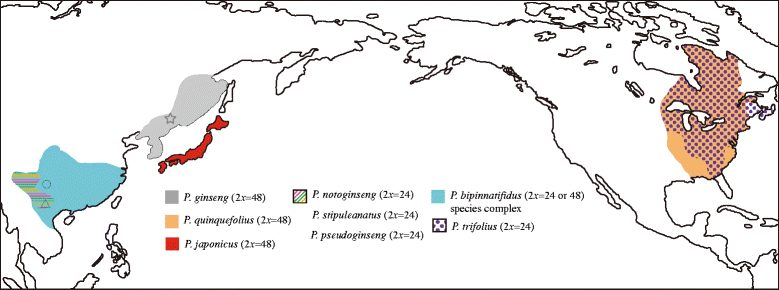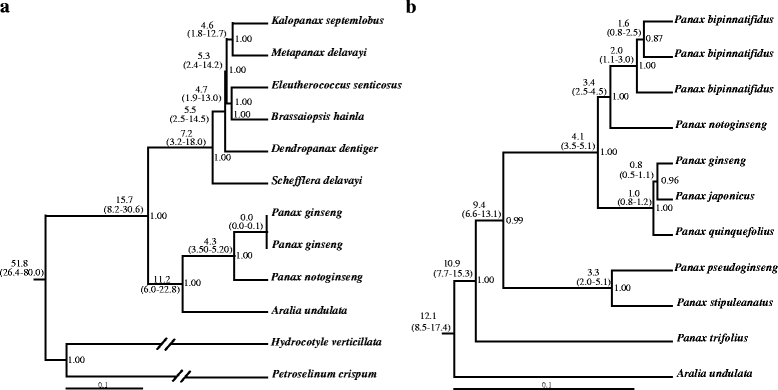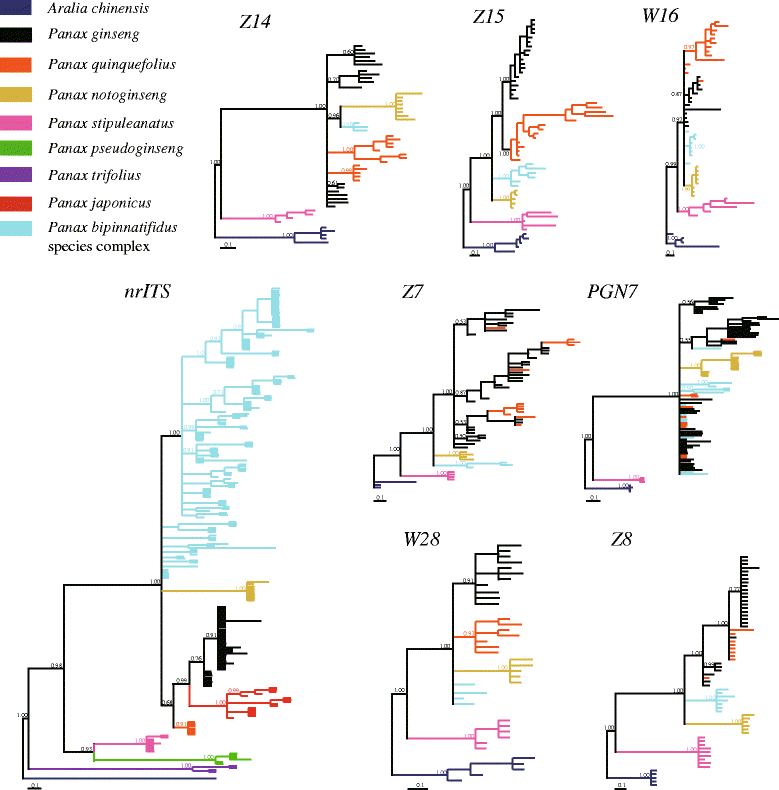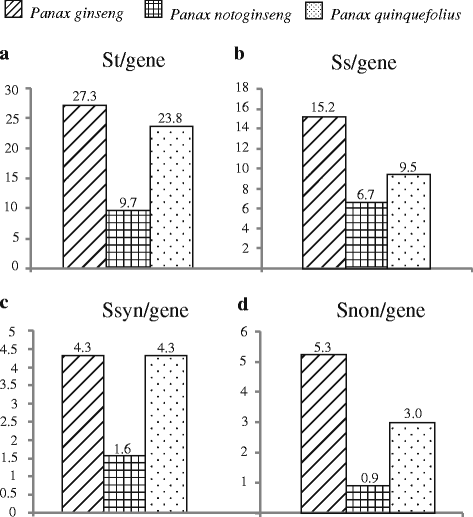The impacts of polyploidy, geographic and ecological isolations on the diversification of Panax (Araliaceae)
- PMID: 26690782
- PMCID: PMC4687065
- DOI: 10.1186/s12870-015-0669-0
The impacts of polyploidy, geographic and ecological isolations on the diversification of Panax (Araliaceae)
Abstract
Background: Panax L. is a medicinally important genus within family Araliaceae, where almost all species are of cultural significance for traditional Chinese medicine. Previous studies suggested two independent origins of the East Asia and North America disjunct distribution of this genus and multiple rounds of whole genome duplications (WGDs) might have occurred during the evolutionary process.
Results: We employed multiple chloroplast and nuclear markers to investigate the evolution and diversification of Panax. Our phylogenetic analyses confirmed previous observations of the independent origins of disjunct distribution and both ancient and recent WGDs have occurred within Panax. The estimations of divergence time implied that the ancient WGD might have occurred before the establishment of Panax. Thereafter, at least two independent recent WGD events have occurred within Panax, one of which has led to the formation of three geographically isolated tetraploid species P. ginseng, P. japonicus and P. quinquefolius. Population genetic analyses showed that the diploid species P. notoginseng harbored significantly lower nucleotide diversity than those of the two tetraploid species P. ginseng and P. quinquefolius and the three species showed distinct nucleotide variation patterns at exon regions.
Conclusion: Our findings based on the phylogenetic and population genetic analyses, coupled with the species distribution patterns of Panax, suggested that the two rounds of WGD along with the geographic and ecological isolations might have together contributed to the evolution and diversification of this genus.
Figures




Similar articles
-
Phylogeny and biogeography of Panax L. (the ginseng genus, araliaceae): inferences from ITS sequences of nuclear ribosomal DNA.Mol Phylogenet Evol. 1996 Oct;6(2):167-77. doi: 10.1006/mpev.1996.0069. Mol Phylogenet Evol. 1996. PMID: 8899721
-
Evolution of the Araliaceae family inferred from complete chloroplast genomes and 45S nrDNAs of 10 Panax-related species.Sci Rep. 2017 Jul 7;7(1):4917. doi: 10.1038/s41598-017-05218-y. Sci Rep. 2017. PMID: 28687778 Free PMC article.
-
Evolutionary Contribution of Duplicated Genes to Genome Evolution in the Ginseng Species Complex.Genome Biol Evol. 2021 May 7;13(5):evab051. doi: 10.1093/gbe/evab051. Genome Biol Evol. 2021. PMID: 33713106 Free PMC article.
-
Dynamic evolution of Panax species.Genes Genomics. 2021 Mar;43(3):209-215. doi: 10.1007/s13258-021-01047-6. Epub 2021 Feb 20. Genes Genomics. 2021. PMID: 33609223 Free PMC article. Review.
-
Ancient WGD events as drivers of key innovations in angiosperms.Curr Opin Plant Biol. 2016 Apr;30:159-65. doi: 10.1016/j.pbi.2016.03.015. Epub 2016 Apr 8. Curr Opin Plant Biol. 2016. PMID: 27064530 Review.
Cited by
-
Reshuffling of the ancestral core-eudicot genome shaped chromatin topology and epigenetic modification in Panax.Nat Commun. 2022 Apr 7;13(1):1902. doi: 10.1038/s41467-022-29561-5. Nat Commun. 2022. PMID: 35393424 Free PMC article.
-
Positive Selection Driving Cytoplasmic Genome Evolution of the Medicinally Important Ginseng Plant Genus Panax.Front Plant Sci. 2018 Apr 4;9:359. doi: 10.3389/fpls.2018.00359. eCollection 2018. Front Plant Sci. 2018. PMID: 29670636 Free PMC article.
-
Genome-Wide Variation Patterns Uncover the Origin and Selection in Cultivated Ginseng (Panax ginseng Meyer).Genome Biol Evol. 2017 Sep 1;9(9):2159-2169. doi: 10.1093/gbe/evx160. Genome Biol Evol. 2017. PMID: 28922794 Free PMC article.
-
No evidence for the radiation time lag model after whole genome duplications in Teleostei.PLoS One. 2017 Apr 20;12(4):e0176384. doi: 10.1371/journal.pone.0176384. eCollection 2017. PLoS One. 2017. PMID: 28426792 Free PMC article.
-
Application of RAD Sequencing for Evaluating the Genetic Diversity of Domesticated Panax notoginseng (Araliaceae).PLoS One. 2016 Nov 15;11(11):e0166419. doi: 10.1371/journal.pone.0166419. eCollection 2016. PLoS One. 2016. PMID: 27846268 Free PMC article.
References
Publication types
MeSH terms
Associated data
LinkOut - more resources
Full Text Sources
Other Literature Sources

